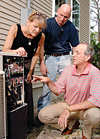
Ductless systems offer advantages in add-on applications, where running new ductwork can be problematic, costly, and labor intensive. Pictured here is the EEZ Duct-Free high-wall split system from Carrier.
The other trends are those the rest of the industry wishes they were seeing: increased consumer recognition of what the ductless (or as Carrier calls them duct-free) products can do.
“Basically in duct-free, the trends are like a lot of the rest of the industry,” Thomas said. Inverter-driven products offer variable-speed performance in- stead of fixed speed, and this affects system efficiency. “Also, people are finding more and more applications for those systems, especially in add-on applications, where they otherwise might have forced a forced-air system in there,” he said. “Rather than bringing in a whole new system, bring in a duct-free add-on.”
Consumer awareness is becoming more prevalent in the United States, he continued. “Duct-free systems have been used around the world; it’s already been used a lot in Asia and Europe.”
RECOGNIZED VALUES
Ductless systems definitely offer advantages in add-on applications, where running new ductwork can be problematic, costly, and labor intensive. “Even in original construction, however, you don’t have to put in the space for the ductwork” when using a ductless system, he pointed out.Ductless systems also offer the benefits of zoning with higher SEER units - again, this has long been a known benefit, but it’s gaining more acceptance in the United States. “If there’s a portion of your house that you’re not using, you just don’t turn it on,” Thomas said.
One of the expanding markets is in commercial renovation work. “It’s being regularly used, for instance, in schools,” he said. Another growing market is in server and high-technology electronics rooms, which can generate a substantial heat load.
“An added complexity in this application is the need to provide cooling in the winter. Our low-ambient kits allow the units to work when outside temperatures go down to -20°F ambient. Some retail places have electronics and surveillance-type rooms. These are not just the high-wall units, he said, but also cassettes and under-ceiling units.
They also can be added to home offices or commercial facilities that might want to change a room into a workout area. “Most of the applications have always been there; people are just recognizing it.”

As ductless systems gain acceptance in the add-on market, one builder has found them to be environmentally acceptable for whole-house HVAC in new construction. Jamie Fowler, co-manager of Four Seasons HVAC, explains his diagnostic testing to homebuilders Pam Fasse and Brad Karl.
BENEFITS TO CONTRACTORS
“Probably one of the biggest benefits to contractors is the installation time,” Thomas said. “There is the indoor unit and the outdoor unit and the connection pipe in between.” Not having to install ductwork, he commented, is a major labor saver.“A contractor is going to renovate a home not having to tear out walls,” he said. It’s also a good thing in old Victorian homes. It typically requires a 3-inch-diameter hole for the connection pipe.
“The space savings is part of the reason it’s used overseas, but in the U.S. segment that has suffered from getting more than they need,” he said.
In addition, “You get the right size that you need.” Sizes range from 9,000 to 360,000 Btu, a good fit for those smaller homes that don’t fit into the sizes of central systems currently available. “You can size it for the room or the application.”
In equipment design right now, “People are trying to keep them thin and away from the wall, unobtrusively blending into the room architecture. Cassettes can be flush to the ceiling, but highwall is the common use.” Other equipment trends include downsizing of the indoor and outdoor units, and horizontal discharge of the outdoor unit. “It lends itself to balcony application. Another feature is the low noise.”
Visit www.carrier.com for more information on the EEZ duct-free high wall split system.
Publication Date:04/28/2008

Report Abusive Comment